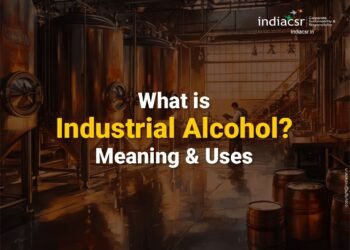Sustainable Aviation Fuel (SAF) offers a viable alternative to conventional jet fuel, significantly reducing greenhouse gas emissions and dependency on fossil fuels.
Sustainable Aviation Fuel (SAF) represents a significant stride towards reducing the aviation industry’s carbon footprint. As the demand for air travel continues to grow, the need for cleaner fuel alternatives becomes increasingly crucial. Sustainable Aviation Fuel (SAF) refers to a category of aviation fuels that offer a significantly lower carbon footprint compared to conventional jet fuel.
They are produced from sustainable feedstocks, such as:
- Used Cooking Oil and Waste Fats: Recycling used cooking oil and waste fats from restaurants and industrial kitchens helps reduce waste and create a valuable resource.
- Plant Oils: Sustainable plant oils, such as those derived from camelina, jatropha, and algae, offer a renewable source of energy for aviation.
- Municipal Solid Waste: Converting municipal solid waste into jet fuel helps divert waste from landfills and reduce greenhouse gas emissions.
- Forest Residues: Utilizing forest residues, such as wood chips and sawdust, from sustainably managed forests contributes to responsible forest management practices.
Key Takeaways
- Global initiatives and supportive policies are crucial for the widespread adoption of SAF, with various governments and international bodies playing pivotal roles.
- Economic and technological challenges remain, with high production costs and the need for advanced technology and infrastructure being major barriers.
- Environmental benefits of SAF include notable reductions in carbon emissions and potential positive impacts on biodiversity through sustainable sourcing.
- Future projections indicate a growing market for SAF, driven by technological innovations and increasing investment in sustainable fuel solutions.

Understanding Sustainable Aviation Fuel
Definition and Types
Sustainable Aviation Fuel (SAF) is a liquid, energy-dense fuel sourced from nonpetroleum sources, known as feedstocks. These include renewable plant-based and waste-based products. Common types of SAF include biofuel derived from materials like algae and used cooking oil, and synthetic paraffinic kerosene produced through the Fischer-Tropsch process.
Benefits Over Conventional Jet Fuel
Sustainable Aviation Fuel (SAF) offers significant environmental benefits by reducing the reliance on fossil fuels and lowering greenhouse gas emissions. The use of SAF can reduce carbon emissions by up to 80% compared to conventional jet fuel, depending on the feedstock and technology used.
Current Production Technologies
The production of SAF currently involves several key technologies:
- Hydroprocessed Esters and Fatty Acids (HEFA): the most widely used technology, converting oils and fats into jet fuel.
- Fischer-Tropsch (FT) synthesis: a process that converts a mixture of carbon monoxide and hydrogen into liquid hydrocarbons.
- Alcohol-to-Jet (ATJ) pathways: these convert alcohols such as ethanol and isobutanol into synthetic jet fuel.
Each technology has its own set of challenges and benefits, which are crucial in determining the sustainability and efficiency of the produced fuel.
*****
Global Initiatives and Policies
International Agreements
The aviation sector has seen significant global collaboration aimed at reducing its environmental footprint. Key international agreements, such as the Corsia agreement under ICAO, set ambitious targets for carbon-neutral growth post-2020. These agreements are pivotal in shaping the future of sustainable aviation fuels (SAF).
Governmental Support and Regulations
Governments worldwide are increasingly backing Sustainable Aviation Fuel (SAF) through various regulations and policies. The European Union adopted the ReFuelEU initiative, which mandates a minimum use of sustainable aviation fuels by airlines operating within its member states. This regulatory support is crucial for accelerating the adoption of SAF.
Incentives for Adoption
To encourage the uptake of Sustainable Aviation Fuel (SAF), governments and international bodies offer a range of incentives. These include tax rebates, subsidies, and grants. For instance, the U.S. provides significant tax incentives for biofuel production, which directly benefits the production and adoption of SAF.
Benefits of Sustainable Aviation Fuel (SAF)
- Reduced Carbon Footprint: Sustainable Aviation Fuel (SAF) can significantly reduce lifecycle greenhouse gas emissions compared to conventional jet fuel, contributing to the aviation industry’s sustainability goals.
- Improved Air Quality: Sustainable Aviation Fuel (SAF) can lead to lower emissions of harmful pollutants, such as particulate matter and sulfur oxides, improving air quality around airports and communities.
- Energy Security: By diversifying fuel sources and reducing reliance on fossil fuels, Sustainable Aviation Fuel (SAF) enhances energy security and resilience.
- Economic Opportunities: The development and production of Sustainable Aviation Fuel (SAF) create new economic opportunities and jobs in the renewable energy sector.
*****
Challenges in Adoption
Economic Barriers
The adoption of Sustainable Aviation Fuel (SAF) faces significant economic barriers. High production costs and the current price gap between SAF and conventional jet fuel deter many airlines from switching. Financial incentives and subsidies could play a crucial role in mitigating these challenges.
Technological Hurdles
Developing technologies that can efficiently produce Sustainable Aviation Fuel (SAF) at scale remains a challenge. The need for advanced research and development is critical to overcome these hurdles and make SAF a viable alternative.
Infrastructure Requirements
The existing aviation fuel infrastructure is predominantly designed for conventional fuels. Adapting this infrastructure to accommodate SAF involves substantial modifications and investments. A strategic approach to infrastructure transformation is essential for the widespread adoption of SAF.
Key Challenges
- Cost: Sustainable Aviation Fuel (SAF) is currently more expensive than conventional jet fuel, posing a challenge for widespread adoption.
- Production Scale: Scaling up Sustainable Aviation Fuel (SAF) production to meet the growing demand of the aviation industry requires significant investments and infrastructure development.
- Feedstock Availability: Ensuring a sustainable and reliable supply of feedstocks is crucial for the long-term viability of Sustainable Aviation Fuel (SAF).
Environmental Impact
Reduction in Carbon Emissions
Sustainable Aviation Fuel (SAF) significantly reduces carbon emissions compared to conventional jet fuels. This reduction is crucial in the aviation industry’s efforts to meet global climate targets. SAF’s ability to lower carbon footprints is a key factor in its growing adoption.
Impact on Biodiversity
The production and use of Sustainable Aviation Fuel (SAF) can have varying impacts on biodiversity, depending on the source materials and production methods used. It is essential to manage these impacts to ensure that SAF contributes positively to environmental conservation.
Lifecycle Analysis
A comprehensive lifecycle analysis of Sustainable Aviation Fuel (SAF) is vital to understand its overall environmental benefits. This analysis considers all stages from production to disposal, providing a clear picture of its environmental footprint. Such analyses help in making informed decisions about the use of SAF in reducing aviation’s environmental impact.
*****
Case Studies
Successful Implementations
JetBlue’s strategic partnership with Carbon Direct is a prime example of successful implementation of sustainable aviation fuel (SAF). This initiative is part of their broader goal to achieve net zero carbon emissions by 2040. The collaboration focuses on developing a diversified SAF procurement strategy, which is crucial for the airline’s sustainability targets.
Comparative Analysis with Traditional Fuels
Comparative studies between SAF and traditional jet fuels show significant reductions in carbon emissions. For instance, using SAF can reduce lifecycle carbon emissions by up to 80% compared to conventional jet fuels. This stark contrast not only highlights the environmental benefits but also underscores the importance of transitioning to SAF.
The Singapore Airlines (SIA) Group has made significant strides in adopting Sustainable Aviation Fuel (SAF).
Also Read:
Future Projections
The future of SAF looks promising with projections indicating a substantial increase in adoption. Experts predict that by 2035, SAF could account for 25% of the global aviation fuel supply. This growth is expected to be driven by technological advancements, increased governmental support, and rising awareness about environmental sustainability.
*****
Innovations in Production
Advancements in Biofuel Technology
Recent breakthroughs in biofuel technology have significantly enhanced the efficiency and sustainability of aviation fuels. Innovative methods such as genetic engineering of algae and yeast have paved the way for higher yield and better quality biofuels. These advancements not only promise a greener future but also align with global decarbonization goals.
Synthetic Fuel Developments
The development of synthetic fuels, also known as e-fuels, represents a major leap forward in sustainable aviation. Utilizing carbon capture technologies, these fuels are produced from CO2 and water, using renewable energy sources. This process, highlighted by Honeywell’s hydrocracking technology, offers a cleaner alternative to fossil fuels and supports the transition to a low-carbon economy.
Utilization of Waste Materials
Turning waste into wealth, the aviation industry is exploring ways to convert organic and non-organic waste into sustainable aviation fuel (SAF). This approach not only reduces waste but also provides a cost-effective source of raw materials for fuel production, thereby supporting both environmental and economic sustainability.
*****
Economic Implications
Cost Analysis
The cost of producing sustainable aviation fuel (SAF) is significantly higher than that of conventional jet fuels. This is primarily due to the advanced technologies and raw materials required. The price differential is a major barrier to widespread adoption. However, as production scales and technologies improve, costs are expected to decrease.
Market Trends
The market for Sustainable Aviation Fuel (SAF) is growing rapidly, driven by increasing regulatory pressures and demand for greener alternatives. Airlines and fuel suppliers are increasingly investing in SAF to mitigate their environmental impact and comply with global emissions standards.
Investment Opportunities
Investment in Sustainable Aviation Fuel (SAF) production facilities and research is seen as a strategic move for future-proofing businesses in the aviation sector. There are numerous opportunities for investors to engage in this burgeoning market, from direct investment in production plants to funding technological research in biofuel and synthetic fuel development.
Future Perspective
Despite these challenges, the aviation industry is actively investing in research, development, and deployment of SAF. Governments and international organizations are also playing a key role in promoting SAF through incentives, policies, and regulations. With continued advancements and collaborative efforts, SAF is poised to play a significant role in decarbonizing the aviation sector and contributing to a more sustainable future.
*****
Conclusion
As the aviation industry continues to seek ways to reduce its environmental footprint, sustainable aviation fuel (SAF) emerges as a pivotal solution. By embracing Sustainable Aviation Fuel (SAF), the industry can significantly cut down on carbon emissions, supporting global efforts to combat climate change. Moreover, the development and adoption of Sustainable Aviation Fuel (SAF) not only contribute to environmental sustainability but also promote energy security and economic stability by diversifying fuel sources and creating new industries. It is imperative for stakeholders, including governments, businesses, and consumers, to support and invest in the advancement of SAF technologies to ensure a greener and more sustainable future in air travel.
*****
Frequently Asked Questions around Sustainable Aviation Fuel (SAF)
What is Sustainable Aviation Fuel (SAF) and why is it important?
Sustainable aviation fuel (SAF) refers to non-conventional aviation fuels that are sustainable as they significantly reduce an aircraft’s carbon footprint compared to conventional jet fuels. These fuels are typically made from sustainable resources such as waste oils, agricultural residues, or other renewable sources. Sustainable Aviation Fuel (SAF) is a type of biofuel made from sustainable feedstocks, such as used cooking oil, animal waste fat, agricultural and forestry waste, or municipal waste. It is very similar in its chemistry to traditional fossil jet fuel.
The importance of SAF lies in its potential to significantly reduce carbon emissions in the aviation industry:
Carbon Emission Reduction: SAF can reduce life cycle greenhouse gas emissions by up to 80% compared to traditional jet fuel. This reduction depends on the sustainable feedstock used, the production method, and the supply chain to the airport.
Energy Density: Jet fuel packs a lot of energy for its weight, enabling commercial flight. Currently, there aren’t any other viable options for transporting groups of people quickly over very long distances.
Compatibility: SAF is compatible with existing aviation engines, distribution infrastructure, and storage facilities3. It can be used as a “drop-in” replacement for conventional jet fuel.
Future of Aviation: With the aviation industry expected to double to over 8 billion passengers by 2050, it is essential to act to reduce aviation’s carbon emissions. SAF is one way to achieve this goal.
How does SAF benefit over conventional jet fuel?
SAF offers numerous benefits over conventional jet fuel, including reduced carbon emissions, improved fuel efficiency, and the potential to utilize renewable and waste materials. This helps in mitigating climate change and reducing reliance on fossil fuels.
What are the current technologies used to produce SAF?
The production technologies for SAF include Hydroprocessed Esters and Fatty Acids (HEFA), Fischer-Tropsch (FT) synthesis, and the Alcohol-to-Jet (ATJ) pathway. These technologies convert biomass and waste oils into high-quality jet fuels.
What global initiatives support the adoption of SAF?
Global initiatives include international agreements like CORSIA (Carbon Offsetting and Reduction Scheme for International Aviation), and various national policies that promote the use of sustainable fuels through subsidies, mandates, and other incentives.
What are the major challenges in adopting SAF?
The main challenges include high production costs, technological barriers in scaling up production, and the need for significant infrastructure investments to handle new types of fuels.
What environmental impacts does SAF have?
SAF can significantly reduce carbon emissions throughout its lifecycle compared to conventional jet fuels. However, the total environmental impact depends on the feedstock used, production technology, and the scale of adoption, which can also affect biodiversity and land use.
In conclusion, Sustainable aviation fuel (SAF) plays a crucial role in providing a cleaner source of energy for the world’s fleet of aircraft, helping billions of people who travel by air each year to lower the impact of their journeys.
(India CSR)

























